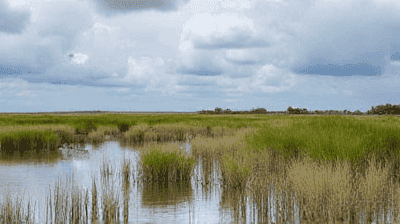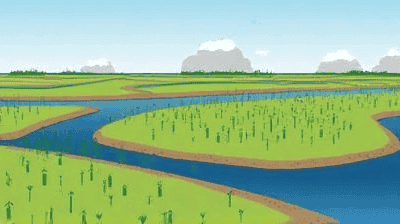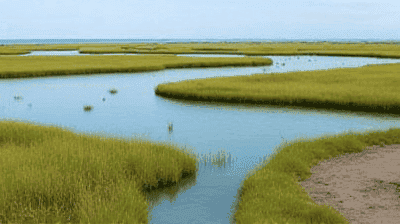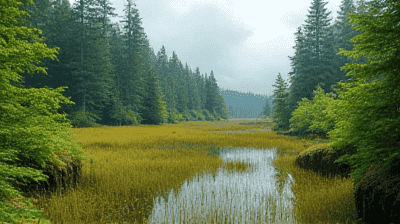
As global sea levels rise due to climate change, the urgency of protecting coastal cities from flooding and erosion has never been more pressing. One of nature’s most effective defenses against these threats lies in coastal wetlands, particularly salt marshes. These unique ecosystems serve as vital buffers, mitigating the impacts of storm surges and rising tides while providing essential habitat for numerous species.
Salt marshes are coastal wetlands characterized by their saline water, which is influenced by the ebb and flow of tides. They are typically found in intertidal zones, where the land is regularly inundated with seawater and where salt-loving plants, known as halophytes, thrive. Common vegetation in salt marshes includes:
These salt-tolerant plants play a critical role in stabilizing soil with their root systems, reducing erosion, and trapping sediments washed in by tides and rivers.
Salt marshes provide various essential ecosystem services:
Flood Protection: The complex root systems of marsh vegetation absorb wave energy and reduce the intensity of storm surges, protecting inland areas from flooding.
Water Filtration: Salt marshes act as natural filters, trapping pollutants, sediments, and excess nutrients before they reach open water systems.
Habitat for Wildlife: These wetlands provide habitat for numerous species, including fish, birds, and invertebrates. Many commercially important fish species use salt marshes as nurseries during their early life stages.
Carbon Sequestration: Salt marshes are incredibly efficient at storing carbon in their plant biomass and sediments, helping to mitigate climate change.
Biodiversity: Salt marshes support a rich diversity of plant and animal life, contributing to the overall health of coastal ecosystems.

Despite their ecological significance, salt marshes face numerous threats that jeopardize their survival:
One of the most significant challenges confronting salt marshes is rising sea levels driven by climate change. As sea levels rise, salt marshes may be inundated more frequently, affecting their plant communities and overall health. If marshes cannot migrate inland due to development, they may become submerged permanently.
Coastal urbanization poses a grave threat to salt marshes. As cities expand into coastal zones, marshes are often drained or filled to make way for infrastructure. This not only results in loss of habitat but also eliminates the natural defense marshes provide against storm surges.
Runoff from agriculture, industry, and urban areas introduces pollutants, excess nutrients, and sediments into salt marsh ecosystems. These pollutants can alter the delicate balance of salt marsh ecosystems, leading to declining plant health and changing species dynamics.
Invasive plant species can outcompete native marsh vegetation, threatening the biodiversity and ecological functions of salt marshes. Common invaders include Phragmites australis (common reed), which can dominate marsh habitats and disrupt ecosystem dynamics.
Coastal areas often experience the risk of oil spills and other industrial activities that can devastate sensitive marsh ecosystems. Oil can coat marsh plants, smothering them and reducing their ability to take in nutrients and perform their ecological roles.
Restoring salt marshes offers numerous environmental and societal benefits:
Enhanced Resilience to Climate Change: Restored marshes can better withstand rising sea levels and increasingly severe storms, providing crucial protection for coastal communities.
Improved Water Quality: By filtering out pollutants and absorbing excess nutrients, restored marshes contribute to healthier coastal waters, benefiting ecosystems and fisheries.
Biodiversity Conservation: Restoration efforts can help re-establish habitats for local wildlife, supporting the recovery of threatened and endangered species.
Carbon Sequestration: Healthy marshes are effective carbon sinks, helping mitigate climate change through carbon storage in biomass and sediments.
Economic Benefits: Healthy salt marshes support local economies by providing recreational opportunities, enhancing fisheries, and increasing property values through natural beauty and flood protection.
Various restoration techniques are employed to rehabilitate salt marsh ecosystems, tailored to the specific conditions and needs of individual sites:
Revegetation: Planting native salt marsh species can help restore vegetation and stabilize soils. Choosing species that are naturally adapted to the marsh environment ensures better survival rates.
Hydrological Restoration: Re-establishing natural water flow patterns and tidal exchange can enhance marsh health. This may involve removing barriers, such as dikes or culverts, and reconnecting marshes with upstream waterways.
Sediment Management: Adding sediments can help raise the elevation of marshes, making them more resilient to rising sea levels. This ought to be done carefully to avoid altering the existing ecosystem negatively.
Invasive Species Control: Managing invasive plant species through mechanical removal, targeted herbicide application, or controlled burns is critical for restoring native biodiversity in salt marshes.
Monitoring and Adaptive Management: Ongoing monitoring of restoration efforts is vital for assessing progress and adapting management practices as needed to achieve desired outcomes.

Numerous successful restoration projects worldwide illustrate the potential of salt marsh revival. Here are a few notable examples:
The Slimbridge Wetland Centre, located in Gloucestershire, is a remarkable example of salt marsh restoration efforts. Initiated by the Wildfowl and Wetlands Trust, this project involves the rehabilitation of existing marsh areas while providing vital habitats for migratory birds.
Techniques Used: The project utilized a combination of hydrological restoration, invasive species management, and revegetation with native plant species.
Results: The area now supports thriving bird populations and has enhanced its capacity to protect coastal communities from flooding.
The Thousand Islands region, located in the St. Lawrence River, has undertaken salt marsh restoration to improve habitat quality and enhance resilience against climate change.
Community Involvement: Local communities participated in restoration activities, including planting native marsh vegetation and removing invasive species.
Outcomes: The project has successfully restored over 100 acres of salt marshes, improving biodiversity and water quality in the region.
In South Florida, extensive restoration activities have been undertaken to revive salt marsh ecosystems in the context of the nation’s largest wetlands—Everglades National Park.
Restoration Activities: Efforts include restoring natural hydrology, removing barriers to tidal flow, and planting native vegetation.
Impact: These efforts have led to increased resilience against flooding and improved habitat for native wildlife, including endangered species like the manatee and various bird species.
Effective policy frameworks are crucial for supporting salt marsh conservation and restoration efforts:
Land Use Planning: Policies that prioritize the protection of coastal wetlands in land-use planning can help reduce urban encroachment on marshes.
Water Quality Regulations: Strong water quality standards reduce pollutant runoff into marshes, preserving their ecological integrity.
Funding for Restoration: Government programs providing funding and resources for wetland restoration projects can empower local communities to take action.
International Agreements: Multilateral agreements, such as the Ramsar Convention, promote the global importance of wetlands and encourage international collaboration on conservation efforts.
Community engagement is vital for the success of salt marsh restoration projects:
Local Awareness Campaigns: Educational initiatives can raise awareness about the benefits of salt marshes and mobilize community support for conservation efforts.
Volunteer Programs: Involving community members in restoration activities fosters a sense of ownership and responsibility for local ecosystems.
Partnerships with NGOs: Collaborating with non-profit organizations can enhance outreach efforts and leverage funding and expertise for restoration projects.
Traditional Ecological Knowledge: Incorporating Indigenous knowledge and practices into restoration planning can enrich the understanding of local ecosystems and improve outcomes.

Despite the successes of salt marsh restoration, several challenges remain on the horizon:
Climate Change Acceleration: With climate change projected to continue influencing sea levels and storm patterns, ongoing adaptation and resilience-building measures are crucial.
Funding Limitations: Securing sufficient funding for large-scale restoration projects may prove challenging, particularly in economically strained regions.
Urban Development Pressures: The ongoing demand for coastal development could continue to threaten existing salt marshes, making advocacy and conservation efforts essential.
While challenges exist, opportunities for enhancing salt marsh protection and restoration abound:
Nature-Based Solutions: Increasing recognition of the value of nature-based solutions for addressing climate change can incentivize investments in coastal ecosystem restoration.
Technological Advancements: Innovations in remote sensing, monitoring technologies, and modeling can enhance our ability to track changes in salt marsh health and effectiveness.
Market-Based Approaches: Payments for ecosystem services (PES) schemes can provide economic incentives for landowners and municipalities to conserve and restore wetlands.
Integrated Coastal Zone Management (ICZM): Coordinated efforts to manage coastal resources on multiple levels can promote collaboration and comprehensive protection for salt marshes.
Salt marshes play a vital role in safeguarding coastal cities from rising seas and climate change impacts. They provide essential ecosystem services, protect biodiversity, and improve water quality. As we confront the dual challenges of urbanization and climate change, salt marsh revival emerges as an urgent necessity.
The successful restoration of salt marshes, exemplified by various initiatives around the world, offers a hopeful model for future endeavors. By prioritizing effective policies, engaging communities, and leveraging opportunities for innovation, we can enhance the resilience of these crucial ecosystems.
Reinvesting in the health of our salt marshes is not only an act of environmental stewardship but also a commitment to safeguarding the future of coastal communities. As we continue to champion salt marsh revival, we must recognize that protecting these vital ecosystems benefits not just the environment, but the very fabric of human society itself.